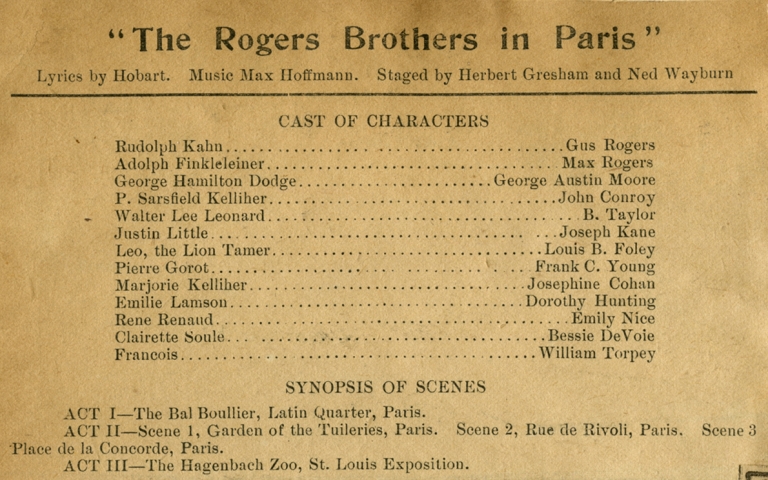Kyle Jolliffe
“The Rogers Brothers in Paris”
Postcards from the Broadway Musical
One common feature of late 19th century American vaudeville theatre was comics who wore make-up such as short, stiff fake beards and then adopted accents to become “Dutch” or Irish characters. The best known “Dutch” (meaning German, from Deutsch) teams were the Rogers Brothers and (Joe) Weber and (Lew) Fields. Both teams used word play based on mispronunciations along with physical comedy like the Three Stooges.
Gus (1869-1908) and his brother, Max (1873-1932) both with thick German-Yiddish accents were the Rogers Brothers. In 1904, one theater critic described them as “irresistibly funny fellows.” Rogers Brothers postcards from the Rotograph Company were among the first (circa 1905) used by the entertainment industry.

The Rogers Brothers adapted their act, as if it were staged in different cities or countries, into a series of popular Broadway musicals. Their musicals, in shorter versions, also toured the country and received high acclaim. The most successful of their productions include The Rogers Brothers in Wall Street (1899), The Rogers Brothers in Central Park (1900–01), The Rogers Brothers in Washington (1901), The Rogers Brothers in Harvard (1902), The Rogers Brothers in London (1903–04), The Rogers Brothers in Paris (1904), The Rogers Brothers in Ireland (1905–06), and The Rogers Brothers in Panama (1907). Each production had a plot with music created around the hapless brothers and ending in comic adventures.

The Rogers Brothers in Paris was a production with a large cast in three acts. The First Act takes place in the Bal Boullier (a Parisian amusement park) and The Latin Quarter (a neighborhood in the 5th arrondissement on the left bank of the Seine and the home of the Sorbonne University and dozens of quaint cafes filled with college aged patrons). The Second Act is in three scenes: one each in the Garden of the Tuileries, along the Rue de Rivoli (a commercial avenue where many of the Parisian fashion houses have their headquarters), and the Place de la Concorde (the site, during the French Revolution, where Louis XVI, Marie Antoinette, and Maximilien Robespierre suffered public executions). The Third Act takes place in a German zoo and the Saint Louis Exposition.
These promotional postcards are from “The Paris” musical. The entire production was managed by the firm of Klaw and Erlanger – a organization that held the brothers under contract.
 |
 |
 |
 |
 |
The actress and dancer Josephine Cohan (1876-1916) had the leading female role in this musical, backed up by what a critic described as the “handsomest girl chorus in existence.” She was the older sister of George M. Cohan and the wife of Fred Niblo, the vaudeville, theatre and pioneer film actor, producer, and director.
The vocal and instrumental songs in this musical are full of gaiety and include The Village Maid, Soldier Boy, and Yankee Land. Phonograph records were produced for these three songs, and audio recordings taken from these records can be heard on the National Jukebox section of the Library of Congress website.
The Village Maid was sung by a male duet, and it is about a rural woman who visits the city and is then pursued by a male suitor. In the sheet music lyrics, the chorus goes:
“For I’m a vil-lage maid
And nev-er should have strayed,
I’ve only seen the vil-lage green and feel a-fraid.
Oh won’t you take me back
to dear old Hack-en-sack
in the city pity any pretty village maid.
For I’m a maid.”

The various Rogers Brothers productions certainly had both charm and a simplicity that disarmed any sort of criticism. It was just one of many comic theatre productions in the early years of the new century with absurd formula plots set in far-off places.
Eventually such productions gave way to the work of others like George Cohan and George Gershwin, and later to the team of Richard Rodgers and Lorenz Hart who together, transformed American musical theater by moving it into a more serious and vigorous style.
I echo TomLeeM’s comment.
A theater historian would definitely value the card which features the names of the actors and roles involved in The Rogers Brothers in Paris.